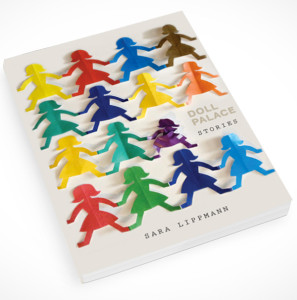 I am especially happy to present this Q&A to you. Sara Lippmann is one of the bright lights of my own writing life, another one of those tremendously gifted writers–and tremendously generous friends–whom I’ve been lucky to get to know since moving (back) to New York City in 2007. I was thrilled to hear that Dock Street Press would be publishing her short-story collection, Doll Palace, and I immediately asked Sara if I could spotlight her work in this space.
I am especially happy to present this Q&A to you. Sara Lippmann is one of the bright lights of my own writing life, another one of those tremendously gifted writers–and tremendously generous friends–whom I’ve been lucky to get to know since moving (back) to New York City in 2007. I was thrilled to hear that Dock Street Press would be publishing her short-story collection, Doll Palace, and I immediately asked Sara if I could spotlight her work in this space.
Sara Lippmann earned a BA from Brown and an MFA from The New School. She has written for magazines, taught college English, and currently co-hosts the Sunday Salon, a monthly reading series at Jimmy’s 43 in New York’s East Village. She is the recipient of a 2012 Fellowship in Fiction from the New York Foundation for the Arts. Her work has appeared in Tupelo Quarterly, Joyland, Mr. Beller’s Neighborhood, PANK, Slice Magazine and elsewhere. Raised outside of Philadelphia, she lives with her husband and children in Brooklyn.
Please welcome Sara Lippmann!
ERIKA DREIFUS (ED): Sara, you are literally one of the nicest, most generous, and most gracious people I know. And yet, I’m often telling you that I find some of your stories “creepy” (“in a good way!” I always hasten to add). For instance, I’ve said repeatedly that the ending of one of your stories [“Everyone Has Your Best Interests At Heart”] leaves me as troubled as does the conclusion of Joyce Carol Oates’s famous “Where Are You Going, Where Have You Been?” To what do you attribute your talent for literary creepiness?
SARA LIPPMANN (SL): Thank you, Erika, for your kind words. That’s how I feel about you! The resources you provide via The Practicing Writer are remarkable. As a longstanding reader, I am regularly blown away by the incredible gems you find and generously share with the literary community. From your newsletter to your author interviews, book reviews, criticism, through all that you do to support fellow writers: we are so grateful.
As for your question: the short answer is I don’t know. I write what interests me, plain and simple, what strums my curiosity and pains my heart, what I struggle to understand. Is that creepy? Not for me. Maybe sometimes what I write is not what one might expect, whatever that means. I get that I’m not exactly an intimidating presence, but God kill me before exiling me to the land of sprites and toadstools. I really don’t see any psychical/physical disconnect. As a reader, my literary tastes have always skewed dark. I like to play around with cultural dictates of innocence and menace. Perhaps it comes from a deeply suburban upbringing, one I know well: the characters/notions/ beliefs of purported safety are always the most terrifying. Tenderness lies outside that frame. In the story you mention, I don’t know that the obvious creep is the creeper. And that’s the thing. Who is ever safe?
ED: DOLL PALACE is being published by a relatively new publisher, Dock Street Press. How did you and your manuscript connect with Dock Street Press?
SL: It was kind of a dream. I’d just put together the manuscript, sent it to a contest or two, a couple of agents (who were encouraging, but the novel, where was the novel, they wanted to know) when Dock Street emailed me out of the blue. They were a new press based in Seattle and somehow had found my stories on the Internet (which still kind of amazes me, that this actually happens) and wanted to know if I had a collection. DSP specializes in narrative that’s not always the smoothest to swallow – and they are devoted to nurturing emerging writers – so it was the perfect match.
When I went out to meet them during AWP [the annual meeting of the Association of Writers and Writing Programs], it only solidified and strengthened this feeling. Dane Bahr and his crew are everything a debut author could hope for and more. They have been extremely thoughtful and hands-on. DOLL PALACE is not exactly a warm and fuzzy book, so I thank my lucky stars they took the chance on me.
ED: How did you decide which stories to include in the collection? And the order in which they appear?
SL: Initially, when I first started thinking about the collection, I included a lot of really short stuff, micros, flash, etc. Many of those pieces fell out. I wanted the book to gel not just thematically but to adhere to a cumulative logic, so that – hopefully – there is an overarching build driven by the order. It took some time to get there. Dane has this wonderful saying (that I’m about to screw up) about how putting together a collection is like arranging the quintessential album, so he was really instructive in pointing out the stories that hit the same one note. We tried to eliminate that kind of repetition, anything that would fall flat or have a dulling effect, and only include the stories that added new beats. I was working in a pretty narrow set of themes, so obviously there is substantial thematic overlap, but the hope is that the stories resonate through the harmony and dissonance of juxtaposition. I cut and swapped. One of my favorite stories, for example, is not here because it did not bring anything new; if anything, it detracted from and muted the others. The order, too, took some fiddling. Early on in the process I had a funny talk with a friend who rated each story on what she called “a dire scale” from 1-5, 5 being the direst. I tried not to place the 5s next to one another. The final story also changed. Though I guess it’s all relative, the new ending is less bleak than the one I’d placed last originally – perhaps, it’s the most hopeful of the lot.
ED: I love that–the idea of a “dire scale”–I guess I can get used to thinking “dire” rather than “creepy.” Now, here’s something [else] that may sound a little odd: Another characteristic that strikes me about your stories is how many of them are set within the Mid-Atlantic region. And they present a far more nuanced portrait of this part of the country than some readers may expect. These are stories spanning Brighton Beach and Bed-Stuy, Brigantine and Bucks County. There are stories set at the beach and stories set in the city. One story takes place on a highway between Manhattan and the Westchester suburbs. (And the stories that do take place elsewhere–out West or in Florida–seem to feature characters only temporarily located in those more distant venues.) To what extent were you conscious of this “regional” element as the collection evolved?
SL: With a few exceptions, the bulk of the settings are settings I know. Knowing this much – not necessarily the specifics of an invented place but the general geography – helps to root my imagination. I wish it were otherwise; if only I could be a writer that creates utterly believable, fully realized worlds out of thin air, absent of all reference points, but (maybe it’s the journalist in me?) with fiction, where everything is unknown and there are infinite possible sunsets to follow, setting is often my one certainty. It makes the process somehow less daunting. If I know this one thing, I tell myself, I’m okay.
I never set out to stake any claim as a regional writer, but it’s true, when it came down to shaping the collection, I cut out most of the stories located outside the Tri-State area. This is my stomping ground, for better and worse. The sensibility is tied to there. Often these settings arrive with the intended mood already built-in, they embody the push and pull of desire, lack, excess, transience, complacency, the ache and budding cognizance that a place has seen its day, that its moment has passed, nothing is what it was. In that way they serve as a kind of shorthand – I guess, you could say I’m cheating.
ED: What’s your greatest hope for DOLL PALACE as it makes its way into the world?
SL: To be read. To have readers – to have people on the other end – who connect with the book. If a light goes off somewhere for someone, if that person pauses and sits up and looks around and says, Yes! Then I’ve done my job. And if that person is moved to tell a friend, and that person tells another friend, well, that’s icing.
ED: Anything else you’d like to share?
SL: Be wary of clueless first time authors issuing unsolicited advice! (Editor’s Note: Sara is NOT clueless!)
That said, writers shopping manuscripts, take heart: It will happen. There is more than one path to publication. Believe in yourself and what you’ve done. It’s easy to get caught up in industry talk, marketplace, trends, agents, etc. but writing is humble business. Be a mensch. Do the work. One word, then another. That’s what matters. We may live in an age of Amazon, of conglomerates, where words like branding and platform are commonplace, but we also live in an age where more and more thoughtful small presses like Dock Street are cropping up, demanding your time and attention. I can’t underline enough how thankful I am to be working with people committed to putting out compelling work regardless of commercial whims – that just really cares about making solid, good-looking books. Books that make you feel. Books that, hopefully, make you think.
ED: Thank you, Sara. Every best wish to you as your collection meets the world. My thanks to Dock Street Press, too, for the advance galley.
Please visit http://dockstreetpress.com/portfolio-item/doll-palace/ to learn more about Sara’s brilliant book!
(A version of this Q&A appeared in the October 2014 edition of The Practicing Writer.)
